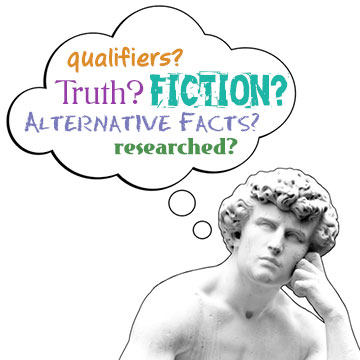 I long for the good ol’ days when everyone agreed that facts were true and fiction was make-believe and made-up facts were lies.
I long for the good ol’ days when everyone agreed that facts were true and fiction was make-believe and made-up facts were lies.
Several years ago, the disseminating of current events entered the truthiness zone — only to emerge in today’s surreal “alternate facts” parallel universe.
It is understandably difficult for many people — and especially young people — to know how to discern factual information from that which is merely purporting to be true. Why should a reader trust the information in a nonfiction book? And as importantly, how do they know it can be trusted? (Beyond, and in addition to, sources, sources, sources!)
Here’s one thing I look for: hedging.
First and foremost, does the author use qualifiers — sparingly — within the text? (A qualifier is a word or phrase added to another word to modify it — usually limiting it, sometimes enhancing it.) Some refer to this as “hedging” and consider it poor authorial form — a sign that someone doesn’t have their facts straight.
But many of us believe it’s just the opposite. A well-placed qualifier signals to the reader that the author is confidently stating a likelihood that falls just shy of certainty — known in academia as a “confident uncertainty.”
Qualifiers such as: seems, appears, suggests, often, or rarely can modify evidence and conclusions that, in most likelihood, are indeed facts, but for various reasons, cannot be proven beyond a shadow of a doubt.
A qualifier tells the reader that the author refuses to simply state something as an irrefutable fact if there is even a smidgen of doubt, or a minute piece of the puzzle that remains unknown or inconclusive.
While it might seem counter-intuitive to judge the trustworthiness of a book that qualifies some of its statements, the very practice shows two critically important things: the author did their research well and understands the topic they are presenting, and the author is not afraid to say what is not known for absolute certain. Such an admission serves only to strengthen the text overall.

Here are four things students can do:
- Have students actively look for the author’s use of qualifiers, such as: approximately, nearly, most, some, sometimes, oftentimes, etc. Why was a particular qualifier used in a given sentence? How did that qualifier help distinguish between the known and the unknown? The nearly certain and the indisputable fact? What questions were raised by the reader when encountering (and pondering) the qualified statement?
- Encourage students to ask questions — particularly about statements that include qualifiers. Encourage them to follow up on their own questions with further research — which will surely lead them on their own path of discovery. The very act of intellectually questioning, of being curious as to why certain things are still unknown, of thinking about how those questions might someday have answers, is precisely what learning is all about.
- Encourage students to read with an open mind and simultaneously a skeptical mind. They should be encouraged to think and ask: okay, how does the author know this? How does the scientist or historian or other expert know what’s being presented is, in fact, true? If the book is well-researched and well-written, the answers to those questions will be evident: they know such-and-such because of all these studies and evidence and documents, which are reliable because of reasons “A,” “B,” and “C”; and they don’t know for certain these few things because the evidence isn’t conclusive yet.
- If a text has no qualifiers, what might that indicate? Encourage students to consider how the absence of qualifiers might raise questions — or pre-empt questions with certainty and clarity.
It is incumbent upon the nonfiction author to build a foundation of trust within the text so the facts and truth can readily be identified by the reader. Sometimes, that means “hedging.” Oftentimes, that leads to reduced ambiguity … and enhanced credibility.
